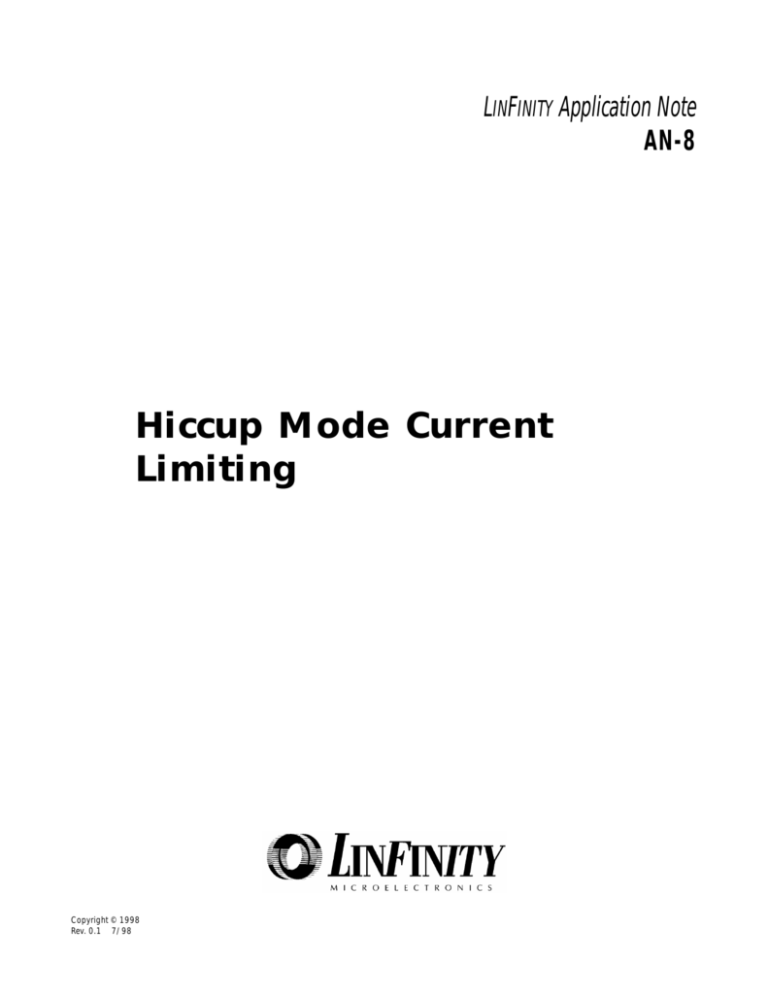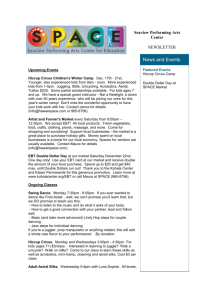AN-8: Hiccup Mode Current Limiting
advertisement

LINFINITY Application Note AN-8 Hiccup Mode Current Limiting Copyright © 1998 Rev. 0.1 7/98 AN-8 Hiccup Mode Current Limiting Application Note INTRODUCTION Hiccup-mode is a method of operation in a power supply whose purpose is to protect the power supply from being damaged during an over-current fault condition. It also enables the power supply to restart when the fault is removed. There are other ways of protecting the power supply when it is over-loaded, such as the maximum current limiting or current foldback methods. One of the problems resulting from over current is that excessive heat may be generated in power devices, especially MOSFET’s and Schottky diodes and the temperature of those devices may exceed their specified limits. A protection mechanism has to be used to prevent those power devices from being damaged. ALTERNATE OVER CURRENT PROTECTION MECHANISMS Maximum Current Limiting In this method, the load current is limited to a set maximum value when the load current demand is higher than that value. As result, the output voltage will drop. The output voltage and load current relationship is shown in Figure 1. Power dissipation in the power supply is usually higher in the current limiting stage than in normal operation, i.e. the power dissipation at point B, as shown in Figure 1, is larger than that at point A. In order to protect the power supply, the system must be designed to handle the worst case thermal dissipation at point C. Current Foldback Current foldback protection reduces the load current when Vo the over-current fault occurs. The IV curve is shown in Figure 2. Because of the current foldback, the worst power dissipation is at point A, hence, the heat sink in this case is smaller than that in the maximum current limiting case. The drawback, however, is that it provides less current at start up, hence the output rises slower, or the power supply may not start up at all if the load current during start up is larger than the foldback current. HICCUP MODE OPERATION The operation of hiccup is as follows. When the currentsense circuit sees an over-current event, the controller shuts off the power supply for a given time and then tries to start up the power supply again. If the over-load condition has been removed, the power supply will start up and operate normally; otherwise, the controller will see another over-current event and shut off the power supply again, repeating the previous cycle. Hiccup operation has none of the drawbacks of the other two protection methods, although its circuit is more complicated because it requires a timing circuit. The excess heat due to overload lasts for only a short duration in the hiccup cycle, hence the junction temperature of the power devices is much lower. The hiccup operation can be done in various ways. For example, one can start hiccup operation any time an overcurrent event is detected; or prohibit hiccup during a designated start-up interval (usually a few milliseconds). The reason for the latter operation is that during start-up, the power supply needs to provide extra current to charge up the output capacitor. Thus the current demand during start-up is usually larger than during normal operation and it is easier for an over-current event to occur. If the power supply starts to hiccup once there is an over-current, it Vo A A B I C I 1/3IMAX IMAX Figure 1: I-V curve for a power supply with maximum current limiting Copyright © 1998 Rev. 0.1 7/98 IMAX Figure 2: I-V curve of a power supply with current foldback LinFinity Application Note Page 2 AN-8 Hiccup Mode Current Limiting C_RESET V_SET 95%V_SET Rss(20K) Css HICCUP RESET Css Q R2(200K) 0.5V UVLO Figure 3. The equivalent hiccup circuit in LX1668. VSET ITRIP TCHG TDCHG Figure 4: The Css voltage (top) and the inductor current (bottom) waveforms during hiccup operation. might never start up successfully. In Linfinity’s LX1668 controller, hiccup mode is inhibited during start up. Figure 3 shows the equivalent hiccup circuit of LX1668. The external soft-start capacitor CSS is used as the timing capacitor for hiccup. CSS will be discharged by R2 (200kΩ 10 times larger than RSS of 20kΩ) during the hiccup operation. During normal operation, any over-current event will produce a current-reset (CRESET) signal to reset the flip-flop and starts discharging CSS through R2. When the voltage of CSS is less than 95% of VSET, however, the Creset signal is prohibited by the AND gate. The inductor current in the buck power stage is limited by the current comparator (refer to the LX1668 data sheet). The CSS voltage and the inductor current waveforms are the ones shown in Figure 4. THERMAL REQUIREMENTS The following section analyzes the thermal requirements of a buck converter with hiccup-mode over-current protection and compares it with the current limiting and the current Copyright © 1998 Rev. 0.1 7/98 fold-back protection methods. Before we do so, let us examine the thermal model of a MOSFET. Thermal Model of a MOSFET Figure 5 shows the thermal model of a MOSFET. The top block represents the junction, which is the source of the heat. The second block is the case of the MOSFET. The third one is the heat sink or the PCB if the MOSFET is surface-mounted. The bottom one is the ambient. Between these blocks are “thermal resistors” (whose values are specified in MOSFET and heat sink data sheets). The heat generated in the junction is dissipated through the thermal resistors to ambient and temperature differences are established between the blocks. The capacitors in Figure 5 represent the thermal capacitance of the case and heat sink. The objective of thermal design is to choose the overall thermal resistance in the heat dissipation path, mainly R3 in Figure 5, so that the temperature in the junction is within certain limit. Of course, this design is done with specified heat power in the junction. The smaller the power dissipated, the smaller the heat sink required. LinFinity Application Note Page 3 AN-8 Hiccup Mode Current Limiting The temperature can be calculated using the electrical equivalent model shown in Figure 6. The counterpart of the temperature in electrical model is the voltage and the heat power in the thermal model is equivalent to a current source in the electrical model. Figure 6 also gives the typical values for the thermal resistors, where R3 = 50Ω (the unit of thermal resistance is °C/W) is the thermal resistance of the PCB with one square inch of copper. C1 is neglected and C2 is selected to be 0.02 because the thermal time constant of the heat sink is in the order of one second. The ambient temperature is usually constant COMPARISON OF PROTECTION MECHANISMS A standard buck converter is used as an example to demonstrate the thermal requirement for each method. Assume that the buck converter is designed for maximum load current of 20A, 5V input, and 2.5V output. The Schottky diode has 0.4V forward voltage drop. Then the worst-case power loss on the diode under normal operation is Ph = I O ,max ⋅V D ⋅ D = 20A ⋅ 0.4V ⋅ 0.5 = 4W ........ (2) Junction R1 Case R2 PCB/Heat sink C1 Ambient R3 C2 where D = 0.5 is the duty ratio for the diode. Therefore, the heat sink should be selected to dissipate 4W heat. Assume that the maximum ambient is 50°C and the maximum temperature at the junction is 125°C to operate safely, then the overall thermal resistance is (125-50)/4 = 18.75°C/W. One needs to select a heat sink with thermal resistance of 18.75-2.5 = 16°C/W for the diode. If the load current increases further, so will the temperature. Thus, the current has to be limited to prevent any further temperature rise. Hiccup Mode Operation Figure 5. Thermal model of a power MOSFET. Any further current increase will lead to shutting off of the converter. In this case, no further temperature rise will occur and the heat sink mentioned above is sufficient. Maximum Current Limiting With current limiting, any further increase in load current will cause the output voltage to drop. As an extreme case, when the output is short-circuited, the output voltage will drop to zero. The on duty ratio of the MOSFET for this case is 0% and the on duty ratio for the Schottky diode is 100%. The current, determined by the limiting value, is constant. The heat power in this case is, Figure 6. Electrical equivalent of the thermal model. therefore is represented by a voltage source V1. When a steady heat is generated in the junction, the junction temperature can be found as, T j = Ph ⋅ 3 ∑R i + T A ......................................(1) Ph = I O ,max ⋅VD ⋅ D = 20A ⋅ 0.4V ⋅ 1.0 = 8W ......... (3) In order for the heat sink to accommodate this worst case, the heat sink needs a thermal resistance of (125-50)/8 2.5 = 6.875°C/W – a much larger heat sink! i =1 where Tj is the junction temperature, Ph is the heat power, and TA is the ambient temperature. For example, if 1W heat is generated in the junction, the ambient temperature is 50 °C, then the temperature at the junction is Tj = 1W*(2+0.5+50)°C/W +50°C = 102.5°C. Current Foldback As shown in Figure 2, this method reduces the output current as the output load increases. Assuming the foldback current is only 1/3 of the maximum current when the output voltage is zero, the heat generated when the output is short-circuited is Ph = Copyright © 1998 Rev. 0.1 7/98 1 3 I O ,max LinFinity Application Note × VD × D .................................. (4) Page 4 AN-8 Ph = 1 3 Hiccup Mode Current Limiting × 20A × 0.4V × 1.0 = 2.67W The worst case condition, from a thermal standpoint, is still the 4W required for normal operation at maximum current, so the same heat sink is required operation for heat dissipation as would be needed in a circuit with hiccup mode protection. The drawback for the foldback Method Hiccup Current Limiting Current Foldback Start up Current Imax Imax Imax/3 Max. Heat Sink Power Dissipation 4W 8W 4W method is that at start up, the current is only one third of the maximum current. Therefore, the power supply will start up much more slowly or may possibly be unable to start up if the load demands a current larger than the foldback current. The three methods are summarized in the following table. Circuit Complexity High Low Medium Comments Best performance Simplest circuit Can not start up with a constant current load CONCLUSION FURTHER INFORMATION Hiccup mode protection will give the best protection for a power supply against over current situations, since it will limit the average current to the load at a low level, so reducing power dissipation and case temperature in the power devices. Its complexity is higher, requiring some extra silicon in the controller IC. However, to the system designer, the added complexity is negligible and provides significant circuit protection benefits. For datasheets and other application notes, please visit Linfinity’s web site at http://www.linfinity.com or use Linfinity’s Fax Back service at 1 (714) 372-3848. Evaluation kits for the LX1668 and other devices are available upon request from Linfinity’s representatives and distributors. The LX1668 programmable switching regulator from Linfinity uses hiccup mode protection to guard against excessive currents. Copyright © 1998 Rev. 0.1 7/98 LinFinity Application Note Page 5






